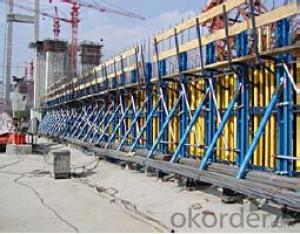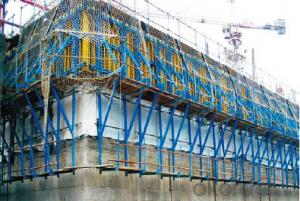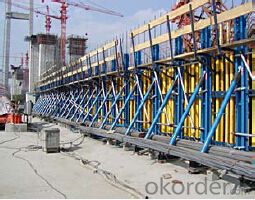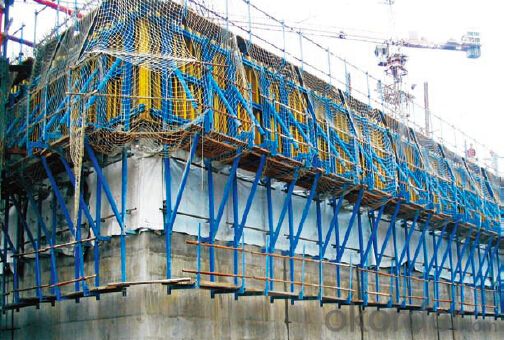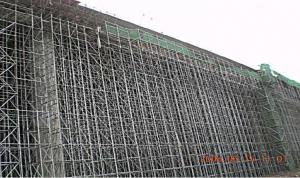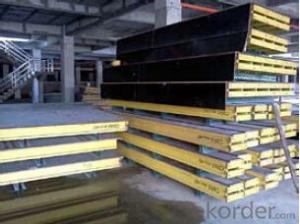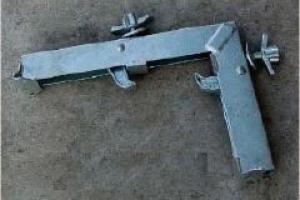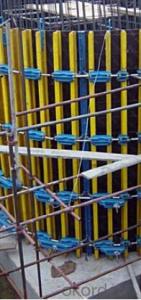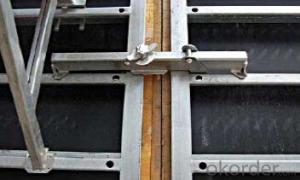Single-Side Climbing Bracket for formwork and scaffolding systems
- Loading Port:
- Tianjin
- Payment Terms:
- TT OR LC
- Min Order Qty:
- 50 m²
- Supply Capability:
- 1000 m²/month
OKorder Service Pledge
OKorder Financial Service
You Might Also Like
Single-side Climbing Bracket SCB180:
With CNBM SCB 180 climbing systems, the loads from the fresh concrete pressure are
transferred through the brackets by means of V-strongbacks and compression braces into the
scaffold anchors.
Typical applications for the SCB 180 are dams, locks, cooling towers, pier heads, tunnels, and
bank vaults.
The formwork is simply tilted backwards when striking takes place. The 1.80 m wide bracket
requires only a minimum of space.
Characteristics:
◆ Economical and safe anchoring
The M30/D20 climbing cones have been designed especially for single-sided concreting using
SCB180 in dam construction, and to allow the transfer of high tensile and shear forces into the still
fresh, unreinforced concrete. Without wall-through tie-rods, finished concrete is perfect.
◆ Stable and cost-effective for high loads
generous bracket spacings allow large-area formwork units with optimal utilization of the bearing
capacity. This leads to extremely economical solutions.
◆ Simple and flexible planning
With SCB180 single-sided climbing formwork, circular structures can also be concreted without
undergoing any large planning process. Even use on inclined walls is feasible without any special
measures because additional concrete loads or lifting forces can be safely transferred into the
structure.
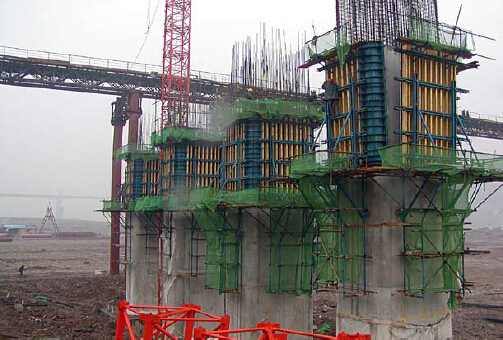
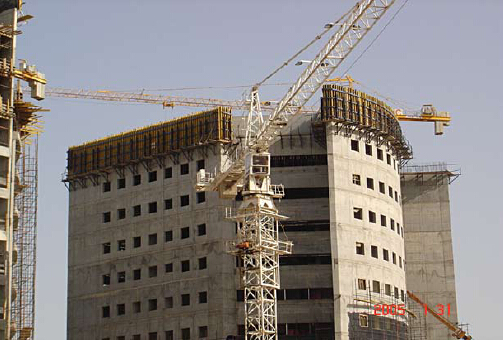
- Q: How does steel formwork contribute to the sustainability of a project?
- Steel formwork contributes to the sustainability of a project in several ways. Firstly, steel is a highly durable material, capable of withstanding the rigors of construction and repeated use over time. This means that steel formwork can be reused multiple times, reducing the need for new formwork to be manufactured for each project. By minimizing the demand for new materials, steel formwork helps to conserve natural resources and reduce the environmental impact associated with the extraction, production, and transportation of construction materials. Additionally, steel formwork offers excellent dimensional stability, which ensures precision and accuracy in construction. This reduces the likelihood of errors and rework, leading to a more efficient use of resources, including time, labor, and materials. The use of steel formwork also results in smooth and high-quality finishes, reducing the need for additional surface treatments or finishes, which can be resource-intensive and contribute to waste generation. Furthermore, steel formwork can be easily dismantled and recycled at the end of its lifespan. The steel can be melted down and repurposed for other construction projects, diverting waste from landfills and reducing the demand for virgin steel production. This closed-loop approach to material use aligns with the principles of a circular economy and helps to reduce the carbon footprint of the construction industry. Lastly, steel formwork provides enhanced safety on construction sites. Its strength and stability minimize the risk of accidents and structural failures, protecting workers and the surrounding environment. By promoting a safe working environment, steel formwork contributes to the overall sustainability of a project by preventing injuries, reducing medical costs, and minimizing the negative social and economic impacts associated with accidents. In summary, steel formwork contributes to the sustainability of a project through its durability, reusability, dimensional stability, recyclability, and safety benefits. By reducing the need for new materials, minimizing waste generation, and enhancing construction efficiency, steel formwork helps to conserve resources, mitigate environmental impacts, and promote a more sustainable construction industry.
- Q: What are the common design considerations for steel formwork in heritage buildings?
- When it comes to the design of steel formwork in heritage buildings, there are various factors that must be taken into account. These considerations aim to maintain the historical and architectural significance of the building while ensuring efficient construction processes. Some of the main design considerations for steel formwork in heritage buildings include the following: 1. Preservation of Historical Value: The primary objective when designing steel formwork for heritage buildings is to preserve and protect the historical elements of the structure. The design must respect the building's original architectural features, materials, and construction methods, while also ensuring that the formwork adequately supports the weight of the concrete during the construction process. 2. Structural Stability: The steel formwork design should provide sufficient support and stability to the structure during the pouring and curing of the concrete. It is crucial to consider the load-bearing capacity of the formwork and ensure that it can withstand the weight of the concrete, reinforcing bars, and construction equipment without causing any damage to the heritage building. 3. Flexibility and Reusability: Since heritage buildings often require restoration or repairs over time, it is essential to design the steel formwork in a way that allows for easy disassembly and reuse. This consideration ensures that the formwork can be removed without causing any harm to the building and can be used again for future construction projects. 4. Aesthetic Considerations: In heritage buildings, maintaining the original architectural aesthetics is of utmost importance. The design of the steel formwork should take into account the visual impact it will have on the structure. This may involve incorporating decorative elements or finishes that match the existing architectural style or using formwork that can be concealed or removed once the concrete is set. 5. Accessibility and Safety: The design of the steel formwork should consider the safety requirements for both construction workers and the general public. It should ensure safe access to different areas of the building during construction and minimize any potential risks or hazards associated with formwork installation and removal. 6. Environmental Considerations: Sustainable design practices should be considered when designing steel formwork for heritage buildings. This may involve using recycled or low-impact materials, minimizing waste generation, and implementing energy-efficient construction techniques. In conclusion, the design considerations for steel formwork in heritage buildings revolve around the preservation of historical value, structural stability, flexibility, aesthetics, accessibility, safety, and environmental sustainability. By addressing these factors, architects and engineers can ensure that the construction process respects the heritage value of the building while meeting modern construction standards.
- Q: What is the maximum load that steel formwork can bear?
- The maximum load that steel formwork can bear depends on various factors such as the type and thickness of the steel used, the design and construction of the formwork, and the support system in place. Steel formwork is known for its strength and durability, making it capable of supporting heavy loads. However, it is important to consult the manufacturer's specifications and guidelines to determine the exact maximum load capacity of a particular steel formwork system. These specifications are typically based on extensive testing and engineering calculations, ensuring the safety and structural integrity of the formwork. Additionally, it is crucial to consider other factors such as the load distribution, formwork layout, and the overall stability of the structure. Professional engineers and contractors should be involved in the design and installation process to ensure that the maximum load capacity is not exceeded and that the formwork is safely supported throughout the construction process.
- Q: How does steel formwork contribute to improved construction efficiency?
- Improved construction efficiency can be achieved through the use of steel formwork, which offers various advantages. To begin with, steel formwork stands out for its durability and strength. It has the ability to withstand heavy loads and extreme weather conditions, enabling construction projects to proceed without interruptions. As a result, builders can work more quickly and efficiently. Furthermore, steel formwork is reusable, unlike traditional timber formwork that often needs to be replaced after a few uses. This reduces the need for constant material replenishment, saving time, cutting down on construction costs, and minimizing waste. Moreover, steel formwork provides excellent dimensional accuracy and stability. It allows for precise shaping and alignment of concrete structures, guaranteeing that they meet the required specifications and standards. This accuracy eliminates the need for rework or adjustments, saving time and resources. In addition, steel formwork is easy to assemble and dismantle due to its modular design. This facilitates quick installation and removal, reducing the time spent on formwork-related activities. This aspect is particularly advantageous for large-scale projects where time is of the essence. Furthermore, steel formwork produces a smooth and even finish on concrete structures, eliminating the need for additional plastering or finishing work. This further enhances construction efficiency. Additionally, the smooth surfaces created by steel formwork are easier to clean and maintain, ensuring a longer lifespan for the structure. Lastly, steel formwork enhances the safety of construction workers. Its strength and stability minimize the risk of accidents or collapses, creating a secure working environment. This, in turn, boosts productivity and efficiency on the construction site. To summarize, the use of steel formwork improves construction efficiency by providing durability, reusability, dimensional accuracy, quick assembly, smooth finishes, and enhanced safety. These factors allow construction projects to progress more rapidly, reduce costs, and deliver high-quality structures within the desired timeframe.
- Q: How does steel formwork affect the overall construction cost estimate?
- Steel formwork can have both positive and negative effects on the overall construction cost estimate. On the positive side, steel formwork is known for its durability and reusability, which can lead to cost savings in the long run. Unlike traditional timber formwork, steel formwork can withstand multiple uses, reducing the need for constant replacement and lowering material costs over time. Additionally, steel formwork provides better dimensional accuracy and stability, resulting in faster construction processes. This can lead to shorter project durations and reduced labor costs, ultimately impacting the overall construction cost estimate positively. However, it is worth noting that steel formwork generally has a higher upfront cost compared to timber formwork. The initial investment required for steel formwork can be significant, especially for large-scale projects. This cost can include the purchase or rental of the steel formwork system, transportation, and installation expenses. Furthermore, steel formwork may require skilled labor for its assembly and dismantling, which can increase labor costs. It is crucial to have experienced workers who are familiar with steel formwork systems, as any mistakes during the construction process can result in additional expenses and delays. Overall, the impact of steel formwork on the construction cost estimate depends on various factors such as the scale of the project, duration, and availability of skilled labor. While steel formwork may have higher upfront costs, the long-term benefits of durability, reusability, and improved construction efficiency can outweigh these initial expenses and positively impact the overall construction cost estimate.
- Q: What are the different types of ties used with steel formwork?
- There are several types of ties commonly used with steel formwork, including snap ties, taper ties, she-bolts, wedge bolts, and pins. These ties help secure the formwork panels together and ensure the stability and strength of the structure being formed.
- Q: How does steel formwork handle different weather conditions?
- Steel formwork is known for its durability and resistance to various weather conditions. It has the ability to handle extreme temperatures, heavy rain, strong winds, and even snow. One of the main advantages of steel formwork is its ability to withstand high temperatures. It does not deform or lose its structural integrity when exposed to extreme heat. This makes it suitable for use in hot climates where temperatures can reach high levels. In addition, steel formwork does not absorb heat easily, which means it remains cool to the touch even in direct sunlight. Steel formwork is also highly resistant to heavy rain and water exposure. It does not rot, warp, or degrade when in contact with water, making it ideal for use in areas with high rainfall or high humidity. Additionally, steel does not absorb moisture, preventing the growth of mold or mildew, which can be a concern with other types of formwork materials. Another advantage of steel formwork is its ability to withstand strong winds. The inherent strength and rigidity of steel make it highly resistant to wind loads. This is particularly important in areas prone to hurricanes, cyclones, or strong gusts of wind. Steel formwork provides stability and ensures that the structure remains intact even during severe weather conditions. Furthermore, steel formwork is capable of handling snow and cold temperatures. It does not crack or become brittle when exposed to freezing temperatures, making it suitable for use in cold climates. The strength and durability of steel formwork ensure that it can handle the weight of accumulated snow without any structural damage. In summary, steel formwork is a reliable and robust solution that can handle different weather conditions effectively. Its ability to withstand extreme temperatures, heavy rain, strong winds, and snow make it a popular choice in construction projects worldwide.
- Q: Can steel formwork be used for post-tensioned concrete structures?
- Yes, steel formwork can be used for post-tensioned concrete structures. Steel formwork is a versatile and durable material that can withstand the forces generated during the post-tensioning process. It provides a rigid and stable support for the concrete to be poured and allows for accurate shaping and positioning of the post-tensioned tendons. Steel formwork offers several advantages for post-tensioned concrete structures. Firstly, it helps in achieving the desired shape and dimensions of the structure by providing a strong and rigid framework. This is crucial for post-tensioned structures as the internal forces generated by the tendons can put significant pressure on the formwork. Secondly, steel formwork allows for easy and efficient installation of the post-tensioned tendons. The formwork can be designed with specific features to accommodate the tendons and their anchorages, ensuring proper placement and alignment. This is important as the tendons need to be accurately positioned to achieve the desired structural performance. Additionally, steel formwork offers good reusability and durability. It can withstand multiple pourings of concrete and can be easily dismantled and reassembled for future use. This makes it a cost-effective choice for post-tensioned concrete structures, especially for projects with repetitive elements. However, it is important to note that the design and construction of steel formwork for post-tensioned concrete structures should be carried out by experienced professionals. This ensures that the formwork can withstand the forces generated during the post-tensioning process and provides the necessary support and alignment for the tendons. Adequate consideration should also be given to factors such as formwork strength, rigidity, and anchorage points to ensure a successful post-tensioning operation. Overall, steel formwork can indeed be used for post-tensioned concrete structures, provided it is designed and constructed appropriately to handle the specific requirements of the project.
- Q: What are the different types of steel connectors used in steel formwork?
- There are several different types of steel connectors that are commonly used in steel formwork, each serving a specific purpose in ensuring the stability and strength of the structure. Some of the most common types include: 1. Wedge connectors: These connectors are used to secure the form panels together. They feature a wedge-shaped design that allows for easy insertion and tight locking, ensuring a strong connection between panels. 2. Bolt connectors: Bolt connectors are used to join steel formwork components together. These connectors typically consist of a threaded rod and nut, providing a secure and adjustable connection. 3. Pin connectors: Pin connectors are often used to connect steel formwork panels. They consist of a pin and a cotter pin, providing a simple yet effective way to secure the panels in place. 4. Clamp connectors: Clamp connectors are used to hold steel formwork panels together. They typically feature a clamping mechanism that allows for quick and easy installation and removal. 5. Hook connectors: Hook connectors are commonly used to connect steel formwork panels to supporting beams or columns. These connectors feature a hook-shaped design that allows for easy attachment and detachment. 6. Bracket connectors: Bracket connectors are used to provide additional support and stability to steel formwork. They are typically attached to the formwork panels and provide a secure connection to the supporting structure. These are just a few examples of the various types of steel connectors used in steel formwork. The specific type of connector used will depend on the requirements of the project and the formwork design. It is essential to select the appropriate connectors to ensure the safety and structural integrity of the formwork system.
- Q: What are the considerations when designing steel formwork for architectural facades?
- When designing steel formwork for architectural facades, there are several important considerations that need to be taken into account. These considerations include: 1. Structural integrity: The formwork must be designed to withstand the weight of the concrete and any additional loads it may be subjected to, such as wind or seismic forces. It should be able to support the weight without any deformation or failure that could compromise the safety of the structure. 2. Aesthetic requirements: Architectural facades often have unique and intricate designs. The formwork should be able to accurately replicate these designs, ensuring that the finished concrete surface meets the desired aesthetic requirements. This may involve the use of custom-made formwork or the incorporation of architectural features within the formwork itself. 3. Ease of assembly and disassembly: The formwork should be designed in such a way that it can be easily assembled and disassembled. This is important for efficiency during construction and for reuse in future projects. The design should allow for quick and simple connections between the formwork elements, minimizing the time and effort required for assembly. 4. Reusability: Steel formwork is often designed to be reusable, which can help reduce construction costs and environmental impact. Considerations should be made to ensure that the formwork can withstand multiple uses without any significant deterioration or loss of performance. 5. Durability: The formwork should be designed to withstand the harsh conditions of construction sites, including exposure to weather, chemicals, and rough handling. The choice of materials and protective coatings should be made to ensure that the formwork can maintain its structural integrity and functionality throughout its lifespan. 6. Safety: Safety is a paramount consideration in construction. The design of the steel formwork should take into account the safety of workers during assembly, disassembly, and concrete pouring. Features such as guardrails, access platforms, and secure connections should be incorporated to ensure the safety of workers. 7. Cost-effectiveness: The design of the formwork should aim to achieve the desired architectural aesthetics while also being cost-effective. This may involve optimizing the design to minimize the amount of steel required or considering alternative formwork materials where appropriate. Overall, designing steel formwork for architectural facades requires a careful balance between structural integrity, aesthetics, ease of assembly, reusability, durability, safety, and cost-effectiveness. By considering these factors, designers can create formwork that meets the requirements of the project while ensuring efficiency and quality in construction.
Send your message to us
Single-Side Climbing Bracket for formwork and scaffolding systems
- Loading Port:
- Tianjin
- Payment Terms:
- TT OR LC
- Min Order Qty:
- 50 m²
- Supply Capability:
- 1000 m²/month
OKorder Service Pledge
OKorder Financial Service
Similar products
Hot products
Hot Searches
